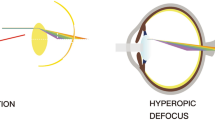Abstract
Pattern reversals with a ramp-like temporal course evoke transient pattern electroretinograms (PERG) that are delayed and attenuated in comparison with responses evoked by a step-like course (abrupt pattern reversals). This delay depends on the reversal time and probably represents a measure for temporal characteristics of the activated retinal structures. A pattern reversal stimulator with adjustable reversa) periods (matrix of 8X14 rectangular red light emitting diodes, element size 2° X 1°, stimulus area 16° X 14°) was used to record transient PERGs from 20 glaucomatous eyes with early or moderate visual field damages (measured with computer perimetry). The q-wave (P1) amplitude difference between the glaucoma group and normal subjects with step-like reversal stimulation was not significantP=0.23). On the other hand, a highly significant separation (P< 0.0001) between both groups was possible using the P1 latency at ramp-like stimulation or the response latency shift between step and ramp-like stimulation (Pattern reversal time, 30 ms).
Similar content being viewed by others
References
Trick GL. Retinal potentials in patients with primary openangle glaucoma: Physiological evidence for temporal frequency tuning deficits. Invest Ophthalmol Vis Sci 1985; 26: 1750–8.
Bach M, Speidel-Fiaux A. Pattern electroretinogram in glaucoma and ocular hypertension. Doc Ophthalmol 1989; 73: 173–81.
Hiss P, Fahl G. Veränderungen im Muster-Elektroretinogramm bei Glaukom und okulärer Hypertension sind reizfrequenzabhängig. Fortschr Ophthalmol 1991; 88: 562–5.
Bielik M, Zwas F, Shin DH, Tsai CS. PERG and spectral sensitivity in ocular hypertensive and chronic open-angle glaucoma patients. Graefes Arch Clin Exp Ophthalmol 1991; 229: 401–5.
Trick GL. The pattern electroretinogram in glaucoma and ocular hypertension. In: Heckenlively Jr, Arden GB, editors. Principles and practice of clinical electrophysiology of vision. Mosby Year Book St. Louis, 1991: 766–72.
Mierdel P, Marré E. Die Auswirkung der Musterumkehrzeit auf die Latenz des M-ERG. Spektrum Augenheilk 1990; 4/5: 188–9.
Towle VL, Sokol S, Moskowitz A, Schwartz B. The visually evoked potentials in glaucoma: Effects of check size, field size and alteration rate [Abstract]. Invest Ophthalmol Vis Sci 1985; 26: 1750–8.
Schmeisser ET, Smith TJ. Flicker VEP frequency response curves in glaucoma. Invest Ophthalmol Vis Sci 1988; 29: 239.
Odom JV, Feghali JG, Jin J, Weinstein GW. Visual function deficits in glaucoma. Arch Ophthalmol 1990; 108: 222–7.
Author information
Authors and Affiliations
Rights and permissions
About this article
Cite this article
Mierdel, P., Zenker, H.J. & Marré, E. The pattern ERG in glaucoma: effect of pattern reversal time. Int Ophthalmol 16, 211–214 (1992). https://doi.org/10.1007/BF00917963
Issue Date:
DOI: https://doi.org/10.1007/BF00917963




